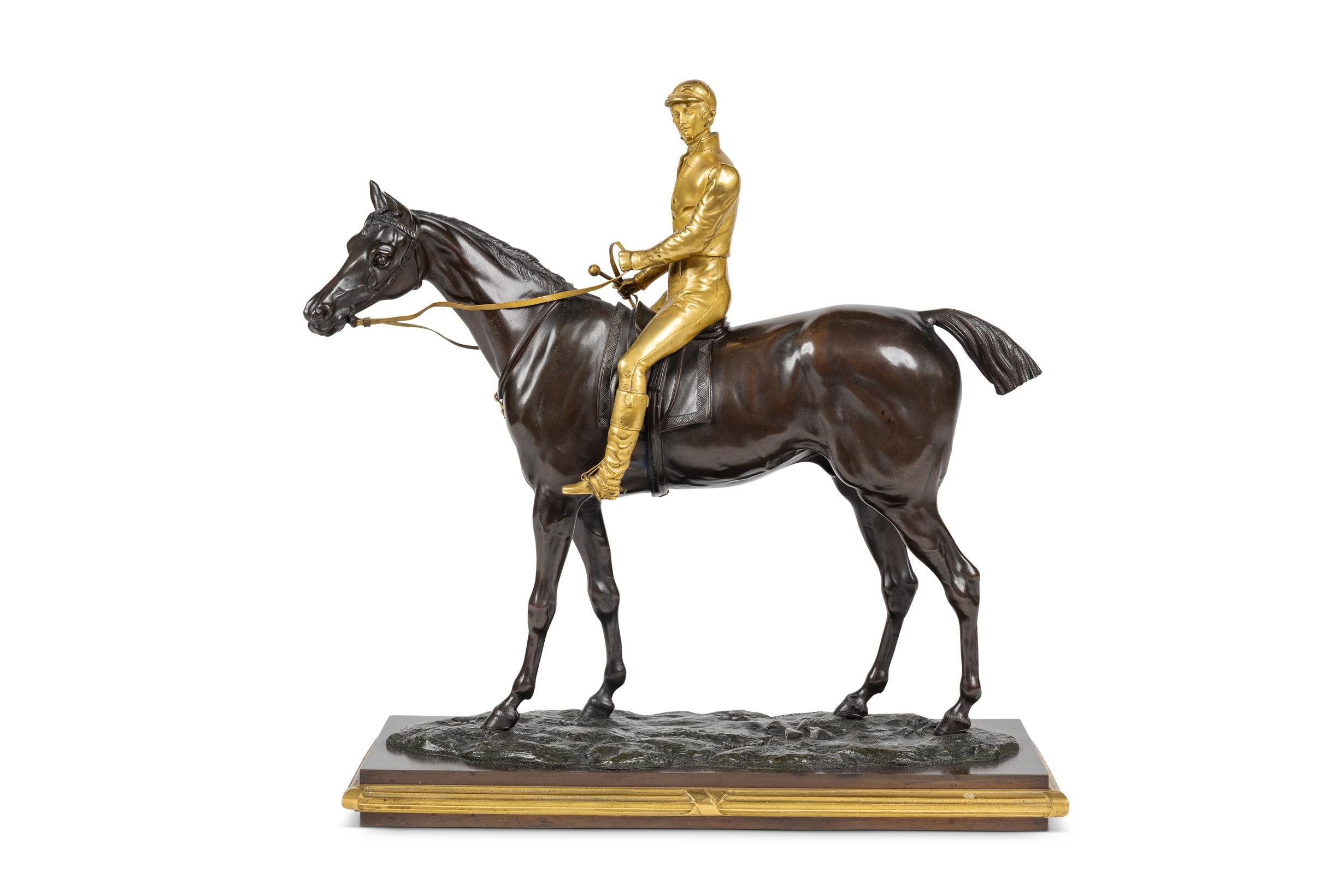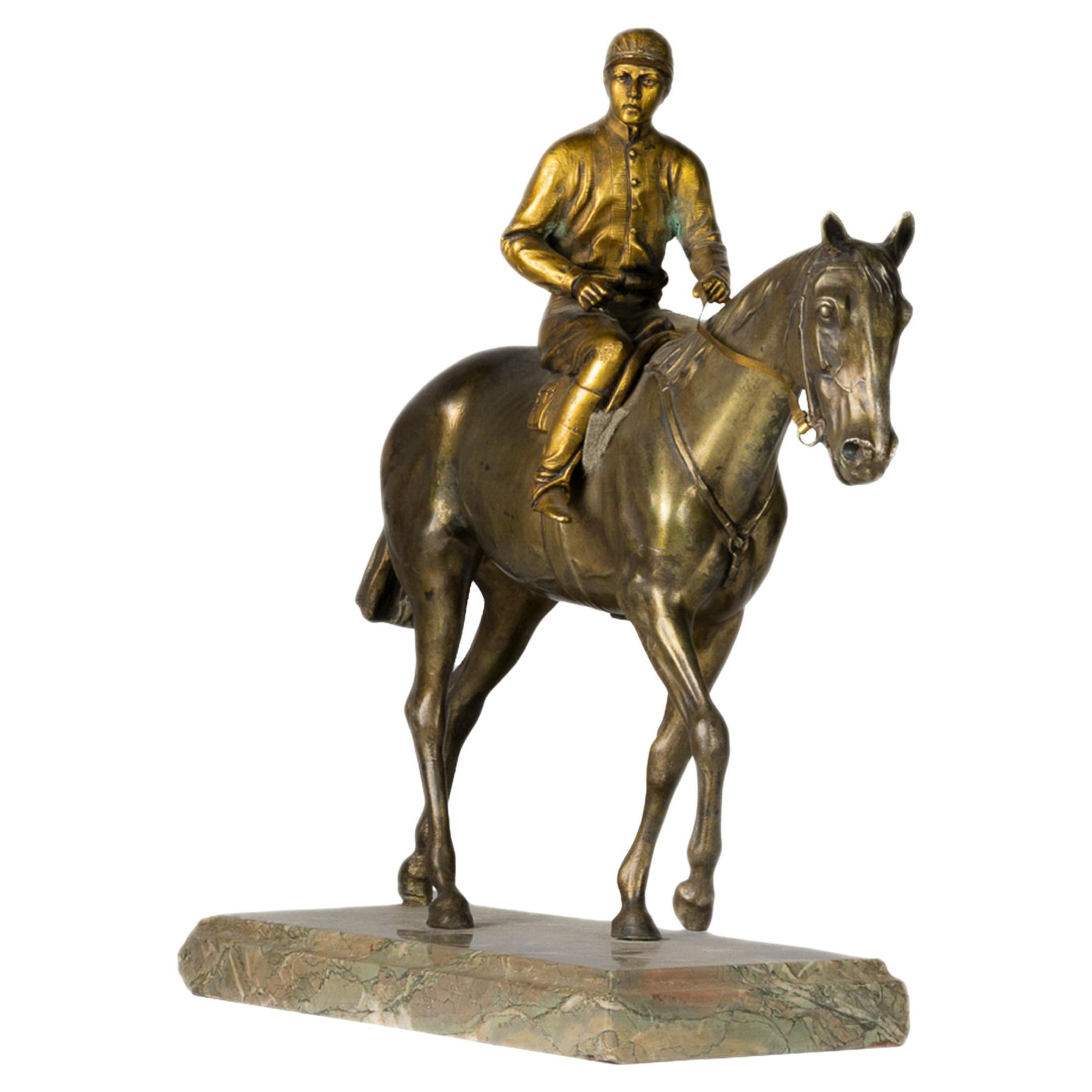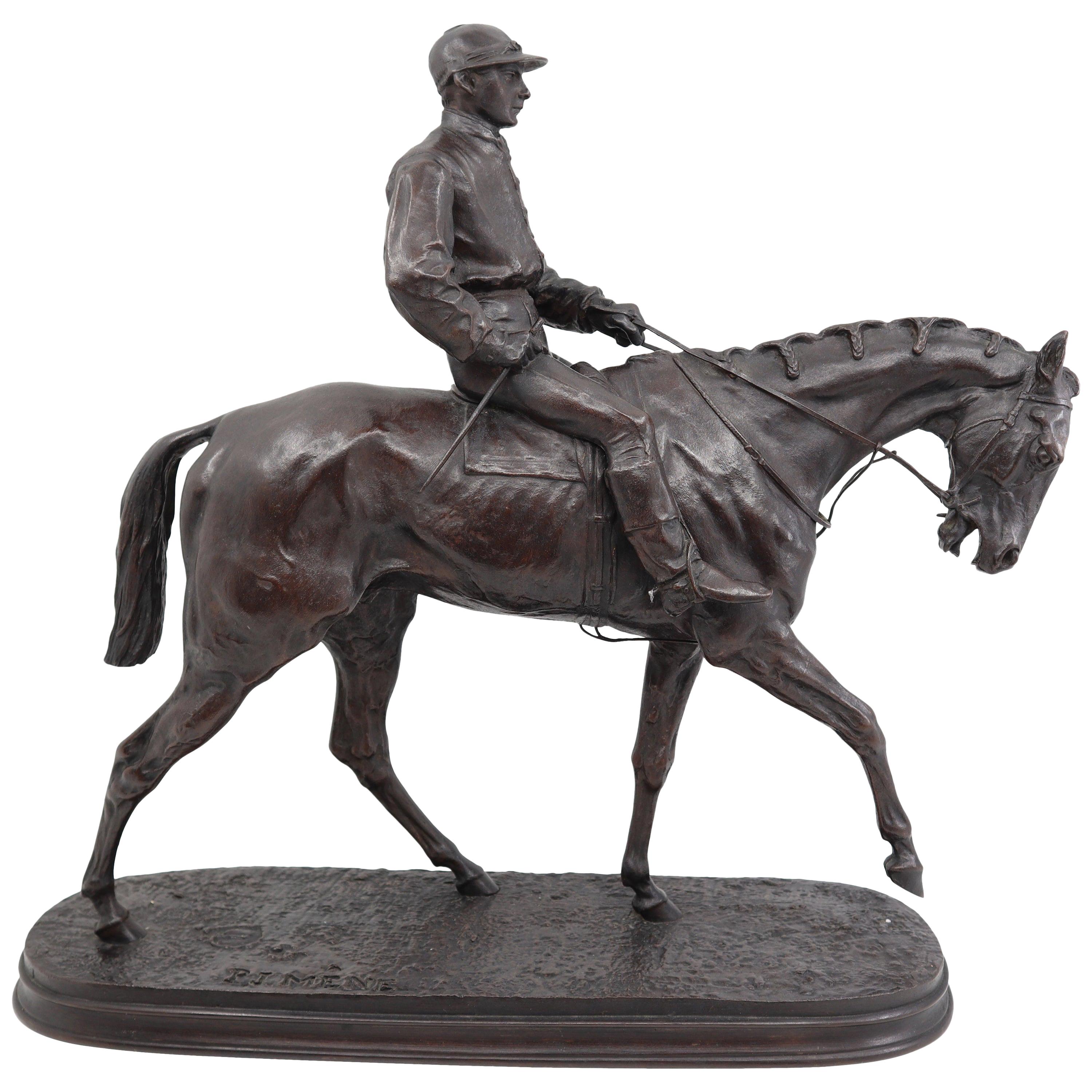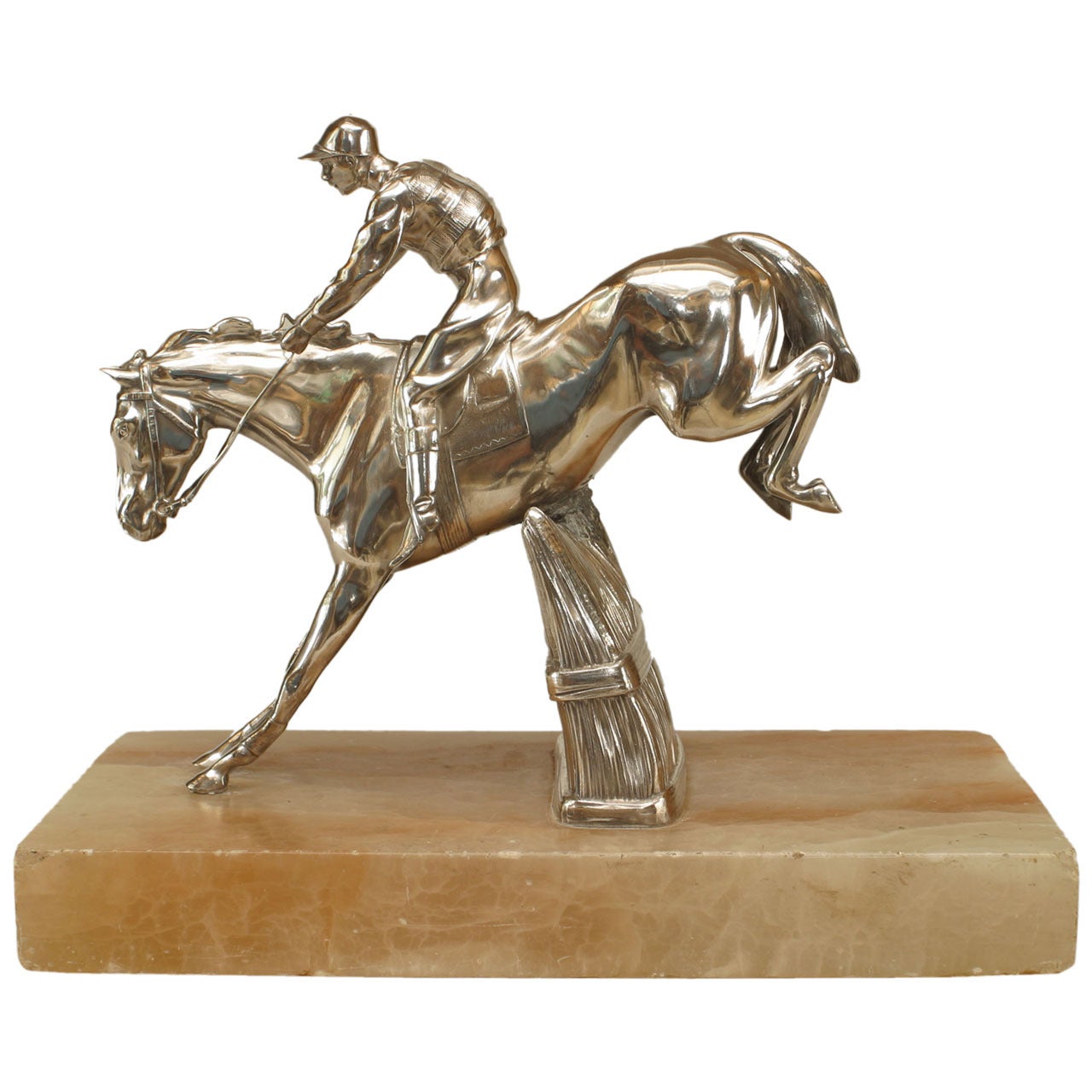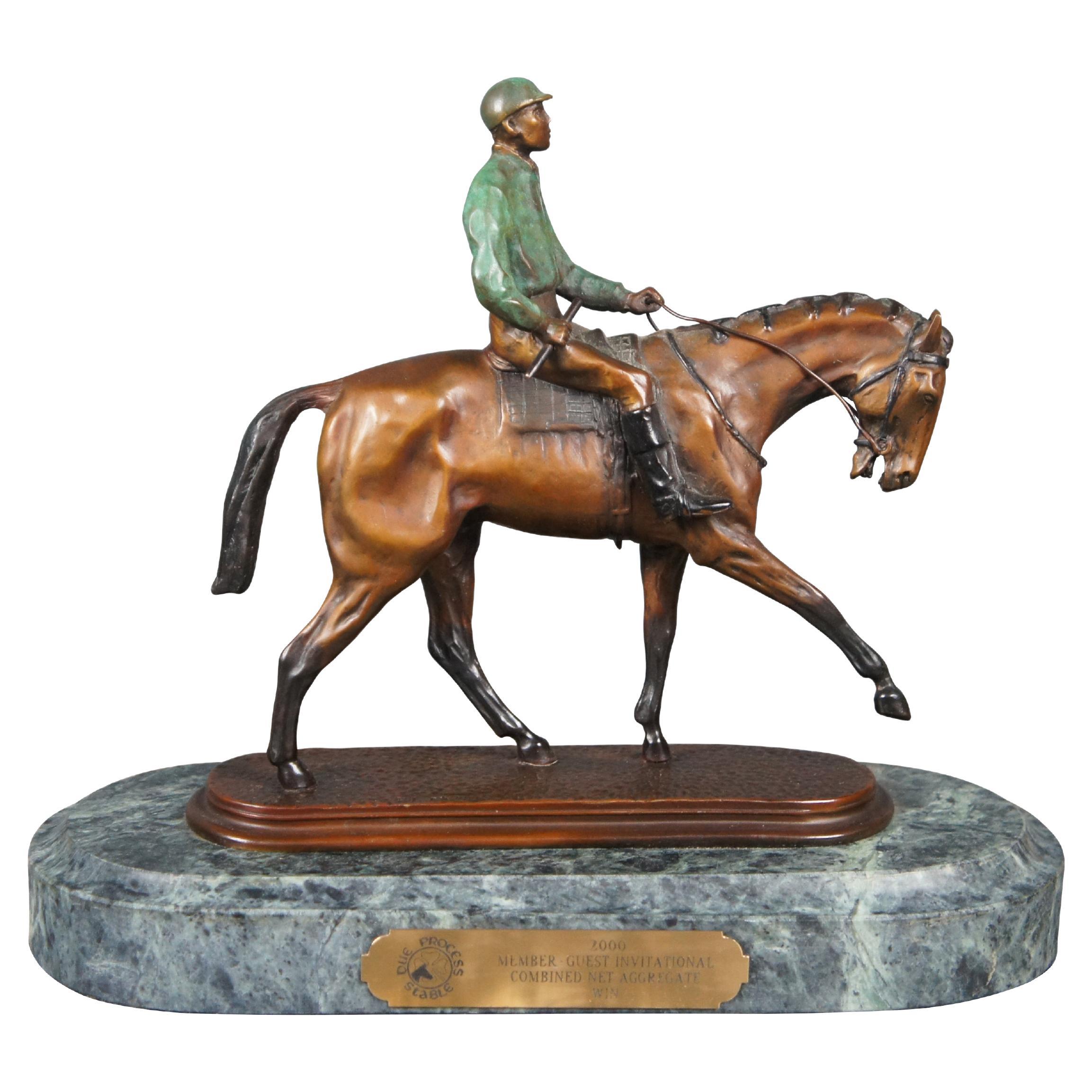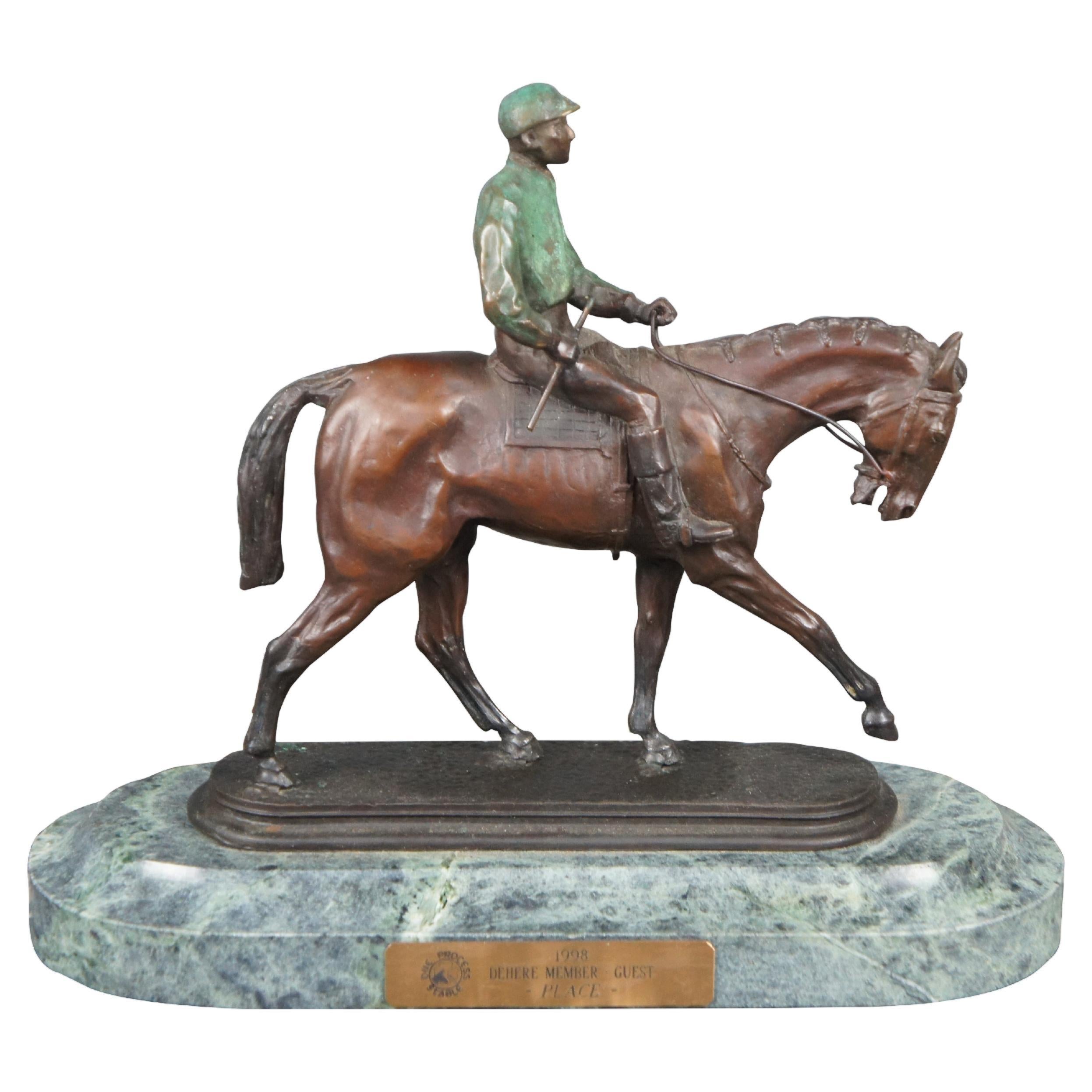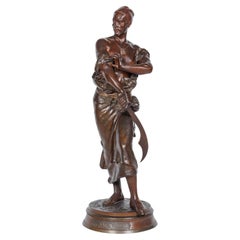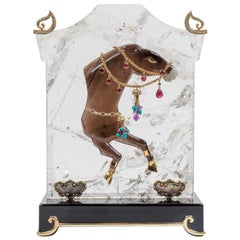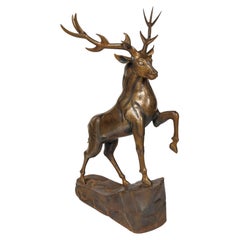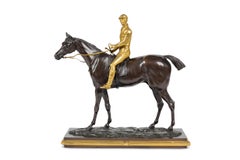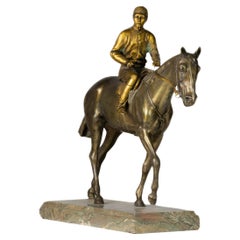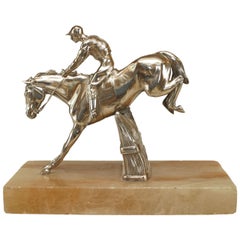Items Similar to Isidore-Jules Bonheur, A Rare Gilt and Patinated Bronze Jockey on A Horse
Video Loading
Want more images or videos?
Request additional images or videos from the seller
1 of 22
Isidore-Jules Bonheur, A Rare Gilt and Patinated Bronze Jockey on A Horse
$14,850
$27,00044% Off
£11,267.84
£20,486.9844% Off
€12,883.77
€23,425.0344% Off
CA$20,741.42
CA$37,711.6844% Off
A$23,061.64
A$41,930.2644% Off
CHF 12,041.52
CHF 21,893.6744% Off
MX$280,716.32
MX$510,393.3144% Off
NOK 153,644.50
NOK 279,353.6444% Off
SEK 143,957.56
SEK 261,741.0144% Off
DKK 96,153.91
DKK 174,825.3044% Off
Shipping
Retrieving quote...The 1stDibs Promise:
Authenticity Guarantee,
Money-Back Guarantee,
24-Hour Cancellation
About the Item
Isidore-Jules Bonheur (French, 1827–1901)
A Rare Gilt and Patinated Bronze Jockey on A Horse, circa 1875.
Introducing a truly exceptional and highly sought-after piece, a rare gilt and patinated bronze sculpture titled "Jockey on a Horse" by Isidore-Jules Bonheur. This remarkable artwork is a testament to Bonheur's mastery as a sculptor, capturing the dynamic energy and grace of both the jockey and his powerful equine companion.
Isidore-Jules Bonheur, a celebrated 19th-century French sculptor, was renowned for his ability to breathe life into bronze. This sculpture exemplifies his exceptional talent and unwavering attention to detail, making it a coveted treasure for art enthusiasts and collectors worldwide.
The sculpture showcases a jockey atop a spirited horse, frozen in a moment of captivating motion. The meticulous craftsmanship is evident in every aspect, from the intricate details of the jockey's attire to the sinewy muscles and flowing mane of the horse. The rich gilt and patinated bronze finish lend a sense of opulence and depth, accentuating the dynamic composition.
The interaction between the jockey and the horse is expertly captured, conveying a sense of harmonious partnership and unity. This remarkable sculpture encapsulates the thrill and spirit of equestrian pursuits, serving as a tribute to the timeless bond between man and horse.
This remarkable artwork not only captures the essence of Bonheur's artistic brilliance but also embodies the spirit of equestrian culture and the rich history of sporting art. Its enduring beauty and universal appeal ensure a desirable addition to any prestigious art collection or as a centerpiece in a sophisticated interior space.
Signed I. Bonheur
A comparable example is in the permanent collection of the Metropolitan Museum of Art
Accession Number: 64.248
Measures: 12" high x 12" wide x 5" deep
Overall excellent condition. Very crisp quality.
- Creator:Isidore Jules Bonheur (Sculptor)
- Dimensions:Height: 12 in (30.48 cm)Width: 12 in (30.48 cm)Depth: 5 in (12.7 cm)
- Style:Sporting Art (Of the Period)
- Materials and Techniques:
- Place of Origin:
- Period:
- Date of Manufacture:C. 1875
- Condition:Wear consistent with age and use.
- Seller Location:Queens, NY
- Reference Number:1stDibs: LU1798235264362
About the Seller
5.0
Vetted Professional Seller
Every seller passes strict standards for authenticity and reliability
Established in 1980
1stDibs seller since 2016
63 sales on 1stDibs
Typical response time: 5 hours
- ShippingRetrieving quote...Shipping from: Queens, NY
- Return Policy
Authenticity Guarantee
In the unlikely event there’s an issue with an item’s authenticity, contact us within 1 year for a full refund. DetailsMoney-Back Guarantee
If your item is not as described, is damaged in transit, or does not arrive, contact us within 7 days for a full refund. Details24-Hour Cancellation
You have a 24-hour grace period in which to reconsider your purchase, with no questions asked.Vetted Professional Sellers
Our world-class sellers must adhere to strict standards for service and quality, maintaining the integrity of our listings.Price-Match Guarantee
If you find that a seller listed the same item for a lower price elsewhere, we’ll match it.Trusted Global Delivery
Our best-in-class carrier network provides specialized shipping options worldwide, including custom delivery.More From This Seller
View AllLe Garde Du Harem, A Monumental Orientalist Bronze Sculpture by G. Coudray
By Georges Charles Coudray
Located in Queens, NY
Le Garde Du Harem, "The Harem Guard" A Monumental Orientalist Patinated Bronze Sculpture by Georges Charles Coudray (French, 1862-1932)
Le Gar...
Category
Antique 19th Century French Figurative Sculptures
Materials
Bronze
Mellerio Paris, A French Gold, Diamond, Silver-Gilt, Rock-Crystal, & Lapis Horse
By Mellerio
Located in Queens, NY
Mellerio Paris, A French Gold, Diamond, Silver-Gilt, Rock-Crystal, Obsidian & Lapis Horse
An extremely rare and unique, one of a kind French gold, diamonds, Silver-gilt rock-crystal, obsidian and lapis lazuli jeweled sculpture "Bucéphale, Chevaux de légende", "Bucephalus, A Legendary Horse" by Mellerio, Paris, circa 1998.
Sitting on black obsidian base, the solid rock crystal slab is finely applied with a lapis lazuli half-horse with harness mounted in 18k gold and brilliant cut diamonds, between two crystal and lapis lazuli columns adorned with gold and diamonds, insert with 7 ruby cabochons and 1 emerald cabochon, the obsidian base with a plaque engraved: CHEVAUX DE LEGENDE / MELLERIO DITS MELLER / PARIS / 5029 DIV
Bucephalus (c355-326 BC) is among the most famous horses in history, and it was said that this he could not be tamed. The young Alexander the Great, of course, tamed him – and went on to ride his beloved equine companion for many years and into many battles.
The piece is in excellent condition and comes with a custom made wood case made for transport. It's very elegant and has French hallmarks throughout. A truly magnificent piece.
Measures 10" high x 9" wide x 4" deep
Founded in France in 1613 by the descendants of Italian immigrants from the Vigezzo Valley in the north of Italy, Mellerio is one of the oldest jewellery houses in Europe. The family business soon attracted the attention of the Royal Court and Marie Antoinette herself reportedly purchased a precious bracelet featuring 7 cameos surrounded by rubies in 1780. Later on, in the 19th century, Mellerio became the official supplier of the French Royal family and the Court of Netherland.
Mellerio creates many jewellery items, all set with rare gems such as peridots, amethysts, aquamarines, citrines and topaz, applying for a patent, the flexible stem, a very supple and light jewellery mechanism. Mellerio remains also well known for their spectacular series of Art Nouveau jewels, created at the beginning of the 20th century, as well as for the creation of trophies rewarding some of the greatest footfall and tennis players of history. In 1993, the jewellery house launched their first watch collection.
Today, Mellerio has stores in Paris, Japan and Hong Kong.
July 14, 1789: this date is known throughout the world as the beginning of the French Revolution. According to a ledger belonging to House of Mellerio, this was also the day that the jeweler sold a golden key to the Comte de Coutance for 10 livres. This ledger, as well as inventories dating as far back as 1768, are the jeweler’s oldest archives. These archives have continued to grow over the years, as the House, established on rue de la Paix in Paris, still lives on today, still in the hands of the same family from Craveggia, in the North of Italy.
The tumultuous history of the Mellerio family in France probably goes as far back as the Italian wars of the Renaissance, but the first official document proving their commercial activity in Paris dates back to 1613. This document is the famous royal warrant awarded by Marie de Medici to a number of Italian families established along the rue des Lombards, including the Mellerios, allowing them to sell “small jewelery items”, therefore granting them a small exception to the traditional monopoly enjoyed by Parisian jewelers. At that time, powerful corporations regulated the operations and customs of Parisian business, but thanks to this exceptional warrant, the Mellerios managed to escape the confines of this framework. Today, this wax-sealed document is kept at the city hall of Craveggia.
From 1613 to the Revolution, the Mellerios lived between France and Italy. The corporations tried many times to put an end to their trade privileges, but all in vain, as a dynasty of sovereigns renewed the warrant. Always marrying and often retiring in Craveggia, the Mellerios continued to maintain their jewelry business in Paris. At first, they did this without a shop. Wearing backpacks (wooden boxes divided into small compartments where jewels were kept), they would tour town fairs around Paris and royal castles.
This is how Jean-Baptiste Mellerio (1765-1850) is said to have sold a bracelet set with rubies and Antique cameos to Marie-Antoinette, which still exists today. Many elements seem to prove the veracity of this anecdote. The queen was particularly fond of cameos, which cover the entire background of her famous jewelry cabinet, and ruby was her favorite stone after diamond. The famous bracelet, reacquired a few years ago by the House of Mellerio, is indeed an 18th century jewel, set with antique cameos representing the profiles of Roman emperors. Two branches of the family were operating in Paris during this time, under the reign of Louis XVI: that of Jean-François (1746-1828), the paternal ancestor of the current Mellerios, and that of Jean-Baptiste (1765-1850).
The French Revolution forced them to return to Italy. However, both Jean-Baptiste and François Mellerio (1772-1843), who was the son of Jean-François, were eventually able to return to Paris after the founding of the Consulate. Jean-Baptiste opened a shop at the Iron Crown of rue Vivienne, and François opened his at the Palais des Tuileries, rue du Coq Saint-Honoré. His well-organized order books give an idea of his high-ranking clientele during the “Old Regime”, among which were the Comte and Comtesse Octave de Segur, the Marquise (later Duchess) de Tourzel, former governess of the royal children, and her daughter, the Comtesse de Bearn, the Craufurds -who organized the flight to Varennes, the Duc and Duchess de Gramont, the Comtesse de Boigne, and Madame de Souza, Talleyrand’s mistress.
We also see the names of the imperial family: Empress Josephine, the Queen of Holland, Princess Elisa, Caroline and Pauline. At that time, the House of Mellerio specialized, among other things, in the trade of antique cameos, a newly fashionable genre of jewel that captured the imagination of all the princesses and noble women of the time.
The years of the Restauration and July Monarchy were among the most glorious. The Bourbons were back on the throne, and the clientele of the House of Mellerio had regained its former wealth. Mellerio supplied Louis-Philippe, Duke of Orléans, as well as his mother, wife and sister, with sumptuous jewels, including a set of emeralds made piece by piece, while the Duke of Bourbon, last prince of the House of Condé, offered diamonds to his mistress, the scheming Baronne de Feucheres, and Monsieur de LaFayette also bought cameos for one of his granddaughters. For the first time, Mellerio ventured into the world of arts in 1815, when Carlotta Grisi, a famous dancer who created Giselle, as well as an actress named Rachel, bought jewels at the Mellerio store on rue de la Paix.
1848 marked a new turning point. France once again became a Republic. François Mellerio handed the company over to his son, Jean, and the latter decided to travel to Spain to build a new clientele. He later became one of the jewelers of the royal family, and met Eugénie de Montijo, who remained a faithful client when she became empress of the French people. The Imperial years were lavish. During the Second Empire, Paris was a pageant of crinoline dresses designed by Worth, while jewels by Mellerio, Worth’s neighbour on the rue de la Paix, adorned the noble women of the Tuileries court.
The Empress bought pearls. Mathilde Bonaparte...
Category
20th Century French Mounted Objects
Materials
Lapis Lazuli, Rock Crystal, Gold, Silver
Mellerio Paris, A French Gold, Diamonds, Silver, and Smoky Quartz Carved Horse
By Mellerio
Located in Queens, NY
Mellerio Paris, A French Gold, Diamonds, Silver-Gilt, Rock-Crystal, Jade, Mother-Of-Pearl and Smoky Quartz, Carved Horse Sculpture, Jeweled Mounted Object.
An extremely rare and unique, one of a kind French gold, diamonds, Silver-gilt, rock-crystal, jade, obsidian, mother-of-pearl, and smoky quartz carved jeweled sculpture "CHEVAUX DE LEGENDE", "A Legendary Horse" by Mellerio, Paris, circa 1991.
Sitting on black obsidian base, the solid rock-crystal slab is finely applied with a carved smoky -quartz and jade horse with a harness mounted in 18k gold, brilliant -cut diamonds, rubies, turquoise, and amethyst chains and pendants. The top columns adorned with 18k gold and brilliant cut diamond pendants, the bottom with gold and mother of pearl plaques. The obsidian base with a plaque engraved: CHEVAUX DE LEGENDE" / N° 05 / MELLERIO DITS MELLER / PARIS / 5003 D
The piece is in excellent condition and comes with a custom made wood case made for transport. It's very elegant and has French hallmarks throughout. A truly magnificent piece.
Measures 10.5" high x 8.5" wide x 4" deep
Founded in France in 1613 by the descendants of Italian immigrants from the Vigezzo Valley in the north of Italy, Mellerio is one of the oldest jewellery houses in Europe. The family business soon attracted the attention of the Royal Court and Marie Antoinette herself reportedly purchased a precious bracelet featuring 7 cameos surrounded by rubies in 1780. Later on, in the 19th century, Mellerio became the official supplier of the French Royal family and the Court of Netherland.
Mellerio creates many jewellery items, all set with rare gems such as peridots, amethysts, aquamarines, citrines and topaz, applying for a patent, the flexible stem, a very supple and light jewellery mechanism. Mellerio remains also well known for their spectacular series of Art Nouveau jewels, created at the beginning of the 20th century, as well as for the creation of trophies rewarding some of the greatest footfall and tennis players of history. In 1993, the jewellery house launched their first watch collection.
Today, Mellerio has stores in Paris, Japan and Hong Kong.
July 14, 1789: this date is known throughout the world as the beginning of the French Revolution. According to a ledger belonging to House of Mellerio, this was also the day that the jeweler sold a golden key to the Comte de Coutance for 10 livres. This ledger, as well as inventories dating as far back as 1768, are the jeweler’s oldest archives. These archives have continued to grow over the years, as the House, established on rue de la Paix in Paris, still lives on today, still in the hands of the same family from Craveggia, in the North of Italy.
The tumultuous history of the Mellerio family in France probably goes as far back as the Italian wars of the Renaissance, but the first official document proving their commercial activity in Paris dates back to 1613. This document is the famous royal warrant awarded by Marie de Medici to a number of Italian families established along the rue des Lombards, including the Mellerios, allowing them to sell “small jewelery items”, therefore granting them a small exception to the traditional monopoly enjoyed by Parisian jewelers. At that time, powerful corporations regulated the operations and customs of Parisian business, but thanks to this exceptional warrant, the Mellerios managed to escape the confines of this framework. Today, this wax-sealed document is kept at the city hall of Craveggia.
From 1613 to the Revolution, the Mellerios lived between France and Italy. The corporations tried many times to put an end to their trade privileges, but all in vain, as a dynasty of sovereigns renewed the warrant. Always marrying and often retiring in Craveggia, the Mellerios continued to maintain their jewelry business in Paris. At first, they did this without a shop. Wearing backpacks (wooden boxes divided into small compartments where jewels were kept), they would tour town fairs around Paris and royal castles.
This is how Jean-Baptiste Mellerio (1765-1850) is said to have sold a bracelet set with rubies and Antique cameos to Marie-Antoinette, which still exists today. Many elements seem to prove the veracity of this anecdote. The queen was particularly fond of cameos, which cover the entire background of her famous jewelry cabinet, and ruby was her favorite stone after diamond. The famous bracelet, reacquired a few years ago by the House of Mellerio, is indeed an 18th century jewel, set with antique cameos representing the profiles of Roman emperors. Two branches of the family were operating in Paris during this time, under the reign of Louis XVI: that of Jean-François (1746-1828), the paternal ancestor of the current Mellerios, and that of Jean-Baptiste (1765-1850).
The French Revolution forced them to return to Italy. However, both Jean-Baptiste and François Mellerio (1772-1843), who was the son of Jean-François, were eventually able to return to Paris after the founding of the Consulate. Jean-Baptiste opened a shop at the Iron Crown of rue Vivienne, and François opened his at the Palais des Tuileries, rue du Coq Saint-Honoré. His well-organized order books give an idea of his high-ranking clientele during the “Old Regime”, among which were the Comte and Comtesse Octave de Segur, the Marquise (later Duchess) de Tourzel, former governess of the royal children, and her daughter, the Comtesse de Bearn, the Craufurds -who organized the flight to Varennes, the Duc and Duchess de Gramont, the Comtesse de Boigne, and Madame de Souza, Talleyrand’s mistress.
We also see the names of the imperial family: Empress Josephine, the Queen of Holland, Princess Elisa, Caroline and Pauline. At that time, the House of Mellerio specialized, among other things, in the trade of antique cameos, a newly fashionable genre of jewel that captured the imagination of all the princesses and noble women of the time.
The years of the Restauration and July Monarchy were among the most glorious. The Bourbons were back on the throne, and the clientele of the House of Mellerio had regained its former wealth. Mellerio supplied Louis-Philippe, Duke of Orléans, as well as his mother, wife and sister, with sumptuous jewels, including a set of emeralds made piece by piece, while the Duke of Bourbon, last prince of the House of Condé, offered diamonds to his mistress, the scheming Baronne de Feucheres, and Monsieur de LaFayette also bought cameos for one of his granddaughters. For the first time, Mellerio ventured into the world of arts in 1815, when Carlotta Grisi, a famous dancer who created Giselle, as well as an actress named Rachel, bought jewels at the Mellerio store on rue de la Paix.
1848 marked a new turning point. France once again became a Republic. François Mellerio handed the company over to his son, Jean, and the latter decided to travel to Spain to build a new clientele. He later became one of the jewelers of the royal family, and met Eugénie de Montijo, who remained a faithful client when she became empress of the French people. The Imperial years were lavish. During the Second Empire, Paris was a pageant of crinoline dresses designed by Worth, while jewels by Mellerio, Worth’s neighbour on the rue de la Paix, adorned the noble women of the Tuileries court.
The Empress bought pearls. Mathilde Bonaparte...
Category
20th Century French Mounted Objects
Materials
Rock Crystal, Jade, Quartz, Gold, Silver
An Exceptional Life-Size Middle Eastern Gold-Inlaid Steel Deer Sculpture
Located in Queens, NY
An Exceptional Life-Size Middle Eastern Gold-Inlaid Steel Deer Sculpture
This extraordinary life-size Middle Eastern deer sculpture exemplifies the pinnacle of artistic craftsmanshi...
Category
20th Century Islamic Animal Sculptures
Materials
Steel
Mathurin Moreau, A Monumental French Bronze and Crystal Figural Centerpiece
By Mathurin Moreau
Located in Queens, NY
Mathurin Moreau (French, 1822-1912)
A Monumental French Bronze and Crystal Figural Centerpiece
Introducing an extraordinary and monumental Fre...
Category
Antique 19th Century French Napoleon III Centerpieces
Materials
Crystal, Bronze
Exquisite Napoleon III French Ormolu Figural Basket Centerpiece, Circa 1880
By Alfred Emmanuel Louis Beurdeley
Located in Queens, NY
An exquisite Napoleon III French ormolu figural basket centerpiece, Circa 1880, Attributed to Alfred Emmanuel Louis Beurdeley.
Depicting four mercury-gilded bronze ormolu cherubs holding a basket, the base with trophies and scrolling.
This monumental centerpiece...
Category
Antique 19th Century French Napoleon III Centerpieces
Materials
Ormolu
You May Also Like
A Rare Gilt and Patinated Bronze Jockey on A Horse, circa 1875
By Isidore Jules Bonheur
Located in Queens, NY
Isidore-Jules Bonheur (French, 1827–1901)
A Rare Gilt and Patinated Bronze Jockey on A Horse, circa 1875.
Introducing a truly exceptional and highly so...
Category
19th Century Figurative Sculptures
Materials
Bronze
$14,850 Sale Price
44% Off
Gilt & Patinated Bronze Jockey on Horse, Marble Base, 19th Century
Located in Lisbon, PT
A French “Jockey à Cheval” sculpture from the Napoleon III period crafted in gilt and patinated bronze, depicting a jockey and his faithful horse in fine detail. The piece rests on a...
Category
Antique 19th Century French Napoleon III Animal Sculptures
Materials
Marble, Metal, Brass, Bronze
$2,803 Sale Price
20% Off
French Bronze Jockey on Horse by Pierre Jules Mêne
By Pierre Jules Mêne
Located in Lantau, HK
A self-taught artist, Piere-Jules Mêne (1810-1879) dedicated his entire career to making bronze statues, which were met with great success among both French and international clients...
Category
Antique 19th Century French Animal Sculptures
Materials
Bronze
Victorian deskBronze Horse and Jockey
Located in Queens, NY
English Victorian silver plated bronze figure of horse and jockey jumping grass fence on white onyx rectangular shaped base
Category
Antique Early 1900s English Edwardian Sports Equipment and Memorabilia
Materials
Onyx, Bronze, Silver Plate
Bronze Horse Jockey Equestrian Racing Trophy Statue After Pierre Jules Mene 10"
By Pierre Jules Mêne
Located in Dayton, OH
Vintage horse trophy / statue / sculpture. Made of bronze featuring an oval marble base and plaque from the Dehere Member Guest Invitational tournament (combined net aggregate win) at Due Process Golf Club and Stables in Colts Neck...
Category
Late 20th Century American Classical Animal Sculptures
Materials
Marble, Bronze
$940 Sale Price
20% Off
Bronze Horse Jockey Equestrian Racing Trophy Statue After Pierre Jules Mene 10"
By Pierre Jules Mêne
Located in Dayton, OH
Vintage horse trophy / statue / sculpture. Made of bronze featuring an oval marble base and plaque from the Dehere Member Guest tournament at Due Process Golf Club and Stables in Colts Neck...
Category
Late 20th Century American Classical Animal Sculptures
Materials
Marble, Bronze
$940 Sale Price
20% Off
More Ways To Browse
Gilt Horse
Horse Jockey
Jockeys And Horse
Jockey Sculpture
Equestrian Jockey
Bronze Jockey
Horse Serving
Bonheur Bronze
19th Century Bronze Equestrian Sculptures
Horse Jockey Sculpture
Bronze Man On Horse
Jockey On Horse Sculpture
Horse And Jockey Bronze
Bonheur Bronze Sculpture
Jockey On Bronze Horse
Vintage Murano Glass Figurine
Brass Duck
German Eagle
